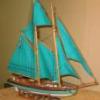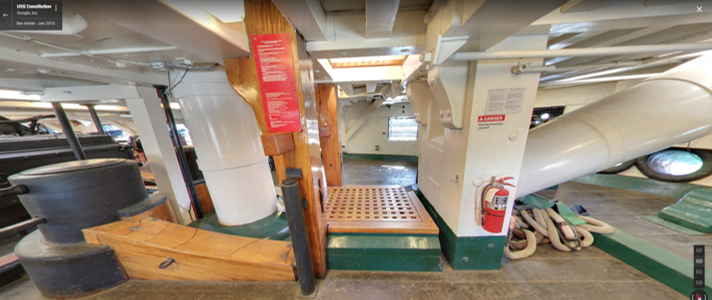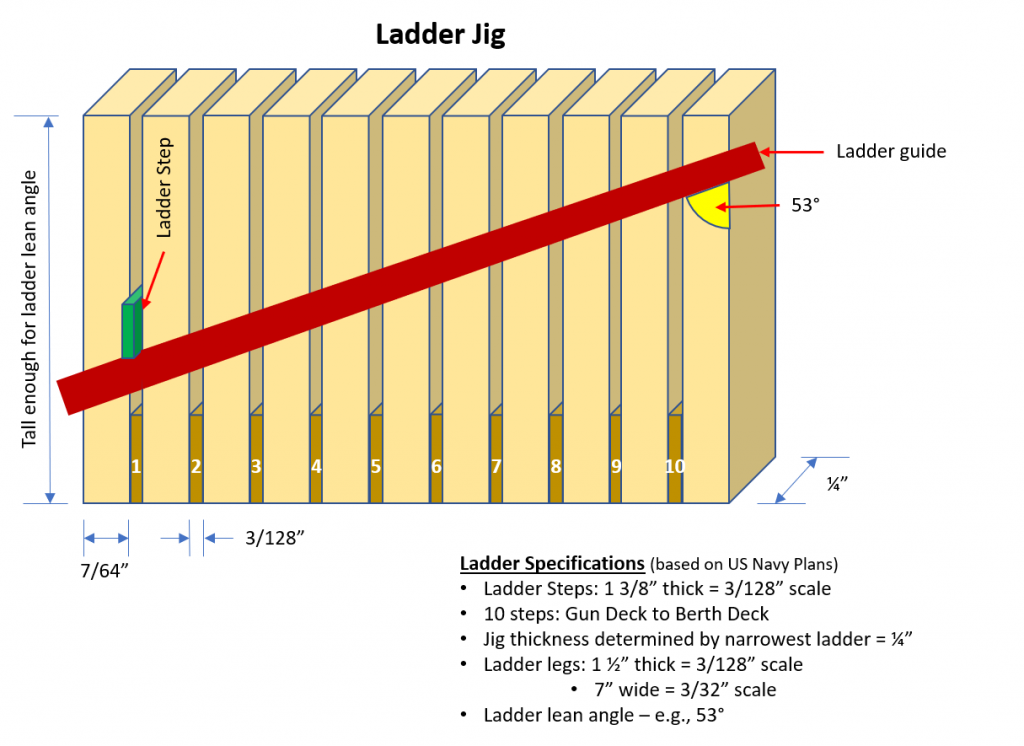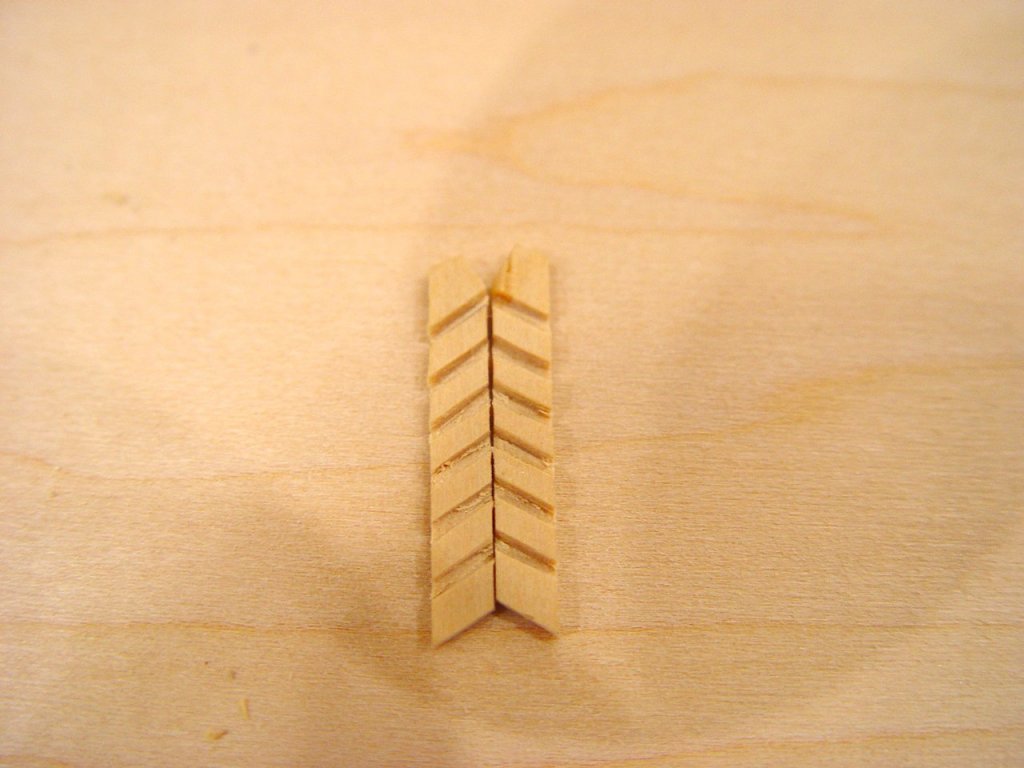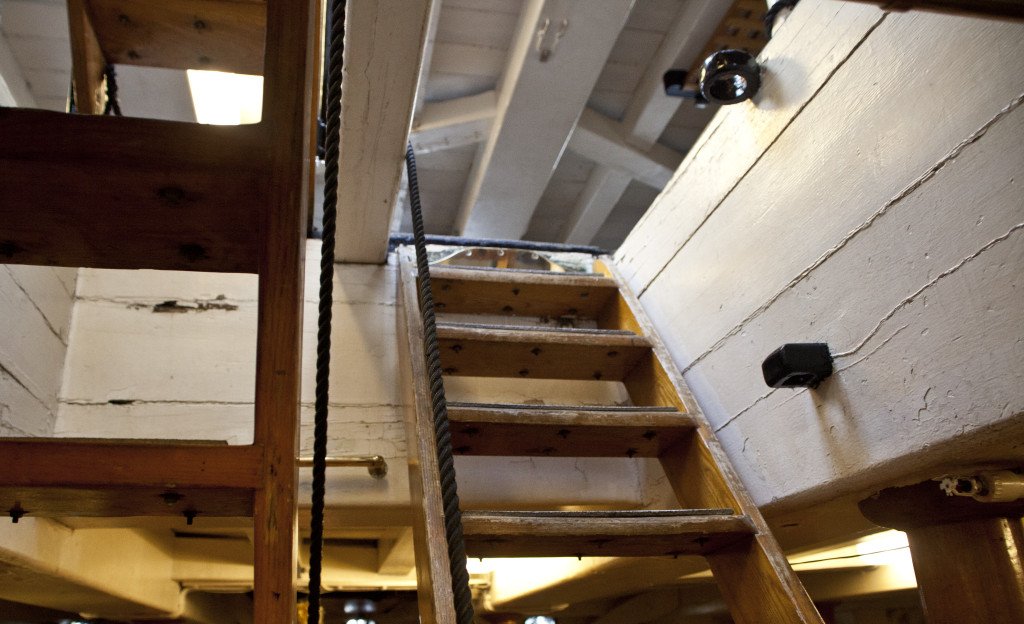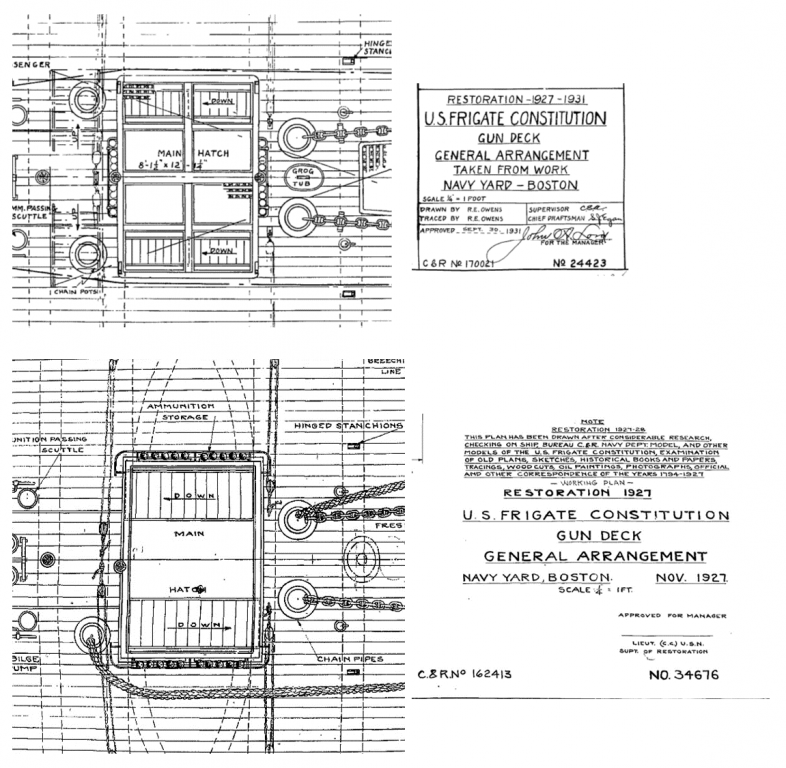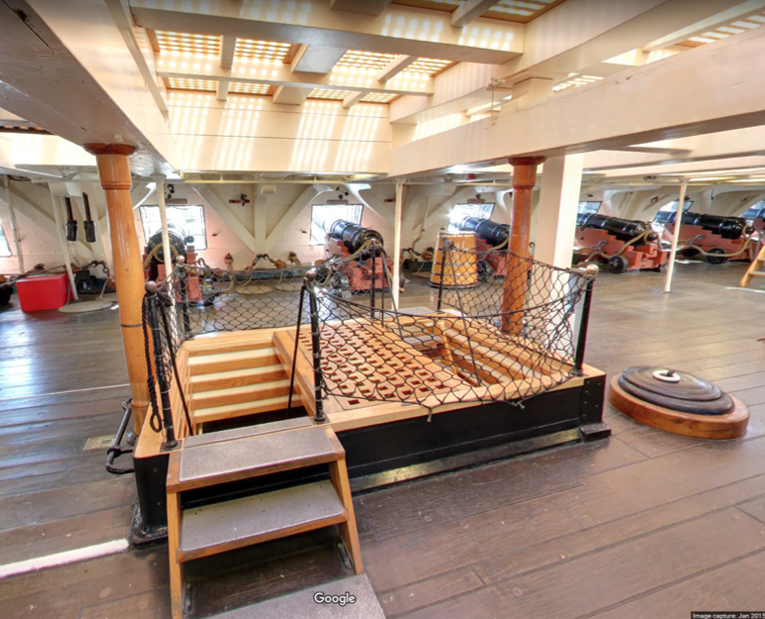-
Posts
2,612 -
Joined
-
Last visited
Content Type
Profiles
Forums
Gallery
Events
Everything posted by JSGerson
-
I thought I was done with the gun deck gratings, but upon checking the Navy plans, it seems I missed one. This was labeled “scuttle” on the plans and it is just aft of the bowsprit support. This one’s a little different from the hatchway gratings as its grating is raised above the scuttle side walls and is painted.
-
As I noted above, I did consider it. The gun deck is going to be only visible through the open areas in the spar deck planking and deck floor support beams. Therefore, the lighting will dim on the gun deck as well as relatively distant from the viewer. So considering the amount of effort required to make those racks, for something that won't be seen unless you have a keen eye and a probe light, I elected not to make them. I will however attempt to make them for the gun deck.
-
Since the chain was already colored black, no color preparation was required. All that was needed was to cut the appropriate length of chain. When laid down on the side of the skylight, the chain was push together so that the links were not visible. In fact, the links made handling quite easy. At this point I had a decision to make: add the ball racks or not. My modeler’s gut reaction was to at least attempt to make them. The practical side said no, no one will see them due to the awkward viewing angle and lighting, not to mention how difficult and delicate they would be to make; at least not on the gun deck, maybe on the spar deck. That was all fine and good for the skylight, but if the cannon balls are to be installed there, I should also install them on the other appropriate hatches. They, however, would be a bit more difficult since they were already installed on the gun deck. By tipping the hull frame on its sides I was able to place and glue the balls into position with CA glue. For those balls which had to be installed on the for and aft sides of the hatches, the hull frame was supported on its transom and stem
-
Cannonball Racks After I added the printed detail on the Captain’s cabin complex, I realized I hadn’t installed the Wardroom skylight grating. I then realized that now would be the most opportune time to add the cannonball racks to the skylight. Because the kit did not provide anything to construct the gun deck, I needed something to represent the cannonballs. Taking a cue from xKen’s (a.k.a. Ken Forman) build, I purchased some black 2 mm ball ball-chain from the jewelry section of Hobby Lobby. The ball size is close enough for this scale.
-
It’s been over a month since my last post. My life has been turned a little topsy-turvy due to my back issue. I’ve been diagnosed with a curvature of the lumbar region of my spine with degenerative disc disease and at least one herniated disc so now I walk with a slight hunch and a bit of pain (sometimes more, sometimes less). The CAT scans and X-rays were not pretty. The good news is that the physical therapy has helped reduce the pain, so I can stand and walk for longer periods of time. Thankfully I get almost total relief when I sit. I was told that if surgery is in my future, it will be complicated and very risky. Oh joy. That being said, I did manage to move forward with build by completing all the stairs going to the berth deck. For something most viewers won’t even see unless they look really close, Still, I had to put in a fair amount of detail. I even prepared the forward-facing wall of the Captain’s cabin complex. It is like the transom cabin with printed detail due to its inaccessibility to the viewer.
-
Very impressive. I too am planning to add bulwark "rivets" But as small as these plastic rivets are, to my eyes (and I use that term lightly as I am blind as a bat without my trifocals), they still seem too large for the scale, especially the height above the surface. I have yet to reach the point in my build where I need to install them so I haven't done any experimentation with various methods I've seen. It may very well be I'll end up doing exactly as you did. If so, I hope to attain the beautiful craftsmanship you achieved. Jon
-
Doc, I had a laminectomy (no fusion) in 1979 and I was pain free until this year. I have no idea yet if the culprit is at the same location or elsewhere. I should know in a few weeks. I am truly sorry about your condition. So far no epidural injections or MRI's (can't have those, I have a pacemaker) and I guess I have not had any EMG's because I don't know what they are. I hope whatever procedure you do end up with works because the alternative is not pretty.
-
I’ve glued a piece of wood to act as a support for the first ladder and I’ve completed all the remaining ladders that go from the gun deck to the berth deck. To install the ladders, the hatches must be glued in, but before I can do that, I had to add the two hatch stanchions that hold the hand ropes. Two more stanchions were added to the base of the ladder and tied with a length of 0.3mm “rope.” The stanchions were made from 0.02” music wire. For the hatch stanchions, I added a tiny blob of PVC glue and painted it with brass paint. I doubt that anyone will notice. The bottom ones are not visible, so they weren’t done. The actual stanchions have rope rings through which the rope is attached, but at these scales and locations, I made it easier for myself and left them off. Finally, I glued the first hatch in place, then the ladder, and finally tied off the ropes to the top stanchion. My back is quickly going down the toilet. I’ve started physical therapy, which has helped some, but I can remain on my feet only a short period of time before I start walking with a limp due to pain. Seems I got some rust on my golden years. I’ve got X-rays, CAT scans scheduled, and an appointment with an Orthopedic doctor. So, we’ll see what happens.
-
For a dry fit, I placed the hatch onto the gun deck to see how it would look. As you can see from the last image, the ladder is hanging out into space. I’ll need to add a small landing for physical support as well as stanchions and the hand rope. One down, four to go. Yes, I know, no one but me will know they are even there.
-
Finally, after waiting about two hours more, I very gingerly slid the ladder out of the jig. The ladder wasn’t perfect. during the gluing process, one of the legs shifted about a millimeter, so the ladder very slightly skewed. It was then given a coat of Wipe-On Poly. This won’t matter much because it will difficult to see. Had this been on the spar deck, I’d do it over. For a first attempt, not too bad.
-
Well, I survived my Mom’s 100th birthday party and surprisingly that went off without a hitch. I did have surprise items for my “To Do”” List, but that is another story. There was one item that affected me: my back. It has been slowly deteriorating to the point now where I’m seeking medical help because it can be quite painful, and it is slowing me down (if that’s possible). So back to the ship yard The angle of the ladder is based on hatch length (the horizontal base) and the vertical height. Since I know the step spacings and the number of steps (10, the full height of the jig), I can lay out the angle on the jig. I drew a vertical reference line first (long pencil line). Then, I measured the base off the model and marked it on the jig (the short pencil mark). The top edge of the guide is placed where the long line meets the top of the guide. The other top edge is placed where the short line meets the bottom of the jig. This held down with double sided tape. The other side of the jig was mirrored the same.
-
Per the US Navy plans, the steps are 1 3/8” thick (3/128” scale) and the legs are 1 ½” thick (3/128” scale). I have seen jigs that use the Byrnes saw (or similar) to cut these slots as well, but at these scales 1/76.8, the slicing blade on the saw is too wide and never mind the minuscule depth cut of the slot that would be needed. In his practicum for the USS Constitution, Mr. Hunt avoided the problem all together by not building the gun deck and not showing any ladders leading to it. I needed something better. I found another ladder building method that other builders have used on this site, albeit at a larger scale, but I going to try it anyways. No leg slots are required. The jig consists of alternate layers of two different thicknesses and lengths of wood glued together in such a way as to create slots of equal spacing. The wood thicknesses represent the step thickness and spacing distance. With aid of a ladder guide stuck on with double sided tape, the steps are placed into the thin slots up against the guide which is set at 53° for example. Because different hatchways have different widths and ladder angles, the jig must accept the narrowest ladder tread such that it extends out on either side to accept the gluing of the ladder legs. I went ahead and built the jig but forgot to account for the ladder lean angle. As a result, my first jig was too narrow (left jig, the revised one is on the right). The second image show the jig after a bit of sanding, and the third image shows it with the angle guides. I’m going to use two to support the steps on both sides to insure all at the same angle. Then the ladder legs will be glued on. I’m going to leave the build at this point as I must get ready for my trip to Mom’s to celebrate her 100th birthday at the beginning of June as I have previously mentioned. We’ll see how well the jig works when I get back to the shipyard.
-
Gun Deck to Berth Deck Ladders One of my building nemeses are ladders. My first and only experience with them was on the Rattlesnake (1/64 scale). According to Mr. Hunt’s practicum, he made his ladders using slots cut into the ladder legs to accept and support the steps. Mr. Hunt did this on his Preac micro table saw without any jigs, and he did it very well. Of course, the scale was a little bit larger and he used larger dimensions. I was able to make mine, but with a lot less finesse and more cursing
-
Hatchway Preparation for Ladders The inside of the hatchways extends down to the bottom of the support 9” (1/8” scale) beams below the gun deck and are painted white. To simulate this, lengths of 3/32” (1/8” less 1/32” plywood = 3/32” scale) thick basswood were glued on the underside of the 1/32” plywood gun deck support. Then the inside of the hatchways and the hatchway framework were painted white. Not anyone will see it when completed, but I just could not leave it alone.
-
The construction of the framework proceeded upside-down using mitered joints. This kept the grating flush with top of the frame. I used mitered joints because of the profile, which was made using the Byrnes saw, an X-acto knife, and files. Lastly, a coat of Wipe-On Poly was brushed onto the bare wood. The last image shows where the frames will be installed after the ladders are fabricated.
-
Because I needed to add a profile to the frame, hardwood was preferred material over basswood which get fuzzy at the edges. From my cache of hardwood, I decided on a whim to use pearwood for the grating frames as opposed to boxwood – a little more contrast for interest. The dimensions were taken from the US Navy plans where possible. The Main Hatch and ladders (grating with ladder openings on either side of it) was guesstimated as the US Navy plans showed two different configurations neither of which matched the one existing today.
-
Access Openings to Berthing Deck In order to progress on the Gun Deck, the deck planking must be installed. But before that can be accomplished, the openings (gratings, hatchways, and ladders) must be constructed and installed first. Since none of the materials to construct these items came with the kit, they had to be fabricated from scratch, well mostly. As I mentioned earlier in this log, I had attempted to procure a second sheet of gratings intended for the Spar Deck to use on the Gun Deck. That didn’t work out so well as Model Expo’s computer couldn’t recognize sales of non-catalog items, but they would send me one for free as part of their replacement policy, which they did.
-
That's one solid looking box. I can see that the boat cradle is solidly fastened to the box, but how is the model firmly attached to the cradle? It almost looks like the cradle vise-grips the keel. Jon
- 1,348 replies
-
- constitution
- model shipways
-
(and 1 more)
Tagged with:
-
Once all the side pieces were installed. The gunport framework had to be trimmed to conform to the hull. This was accomplished with grease…elbow grease and sanding sticks. I suppose I could have trimmed the excess wood with a knife, but I was afraid that I might cut too much accidentally or worse, cut me. Although sanding slow, it’s more controllable. You can see the trim difference in the before and after images
-
The spacer which I used to install the gunport headers was designed so that its cross section was exactly the dimensions of the opening of the gunports. The side pieces were pressed against the spacer sides and glued into place completing the gunport framework. Some of the gunports were formed with one bulkhead as the gunport side, others with two pieces I cut as dictated by the plans.
-
Since my last post, I’ve been to Florida to visit Mom for a week and will do so again in June for her 100th birthday. A little celebration, you know the usual stuff: skydiving, a bit of scuba in the Atlantic, a spin in a race car at Daytona, and a wild party in the evening…….Riiiigggght!!! Wishful thinking. Friends and family will drop by to bestow their good wishes, maybe some cake and ice cream. Back at the shipyard, I’ve added the gunport header using the same spacer method.
-
Jim Lad posted April 8, 2013 on Modeller12's Constitution build log, the following: BANYAN added in the same post: I hope this helps Jon
- 742 replies
-
- constitution
- frigate
-
(and 1 more)
Tagged with:
-
I did not mean to burst your bubble. We all make compromises as we construct our builds. We are making models, not necessarily miniature duplicates of the real thing. As you have acknowledged, a model can be as simple or as complicated as we choose to make it. I provided the information to you for your knowledge, not for the observer of the model. You do with it as you see fit. I have yet to see two models of the same ship that are duplicates of each other. That prototype cannonade is a little masterpiece, as you should be proud of it. Keep up the good work. Jon
About us
Modelshipworld - Advancing Ship Modeling through Research
SSL Secured
Your security is important for us so this Website is SSL-Secured
NRG Mailing Address
Nautical Research Guild
237 South Lincoln Street
Westmont IL, 60559-1917
Model Ship World ® and the MSW logo are Registered Trademarks, and belong to the Nautical Research Guild (United States Patent and Trademark Office: No. 6,929,264 & No. 6,929,274, registered Dec. 20, 2022)
Helpful Links
About the NRG
If you enjoy building ship models that are historically accurate as well as beautiful, then The Nautical Research Guild (NRG) is just right for you.
The Guild is a non-profit educational organization whose mission is to “Advance Ship Modeling Through Research”. We provide support to our members in their efforts to raise the quality of their model ships.
The Nautical Research Guild has published our world-renowned quarterly magazine, The Nautical Research Journal, since 1955. The pages of the Journal are full of articles by accomplished ship modelers who show you how they create those exquisite details on their models, and by maritime historians who show you the correct details to build. The Journal is available in both print and digital editions. Go to the NRG web site (www.thenrg.org) to download a complimentary digital copy of the Journal. The NRG also publishes plan sets, books and compilations of back issues of the Journal and the former Ships in Scale and Model Ship Builder magazines.


